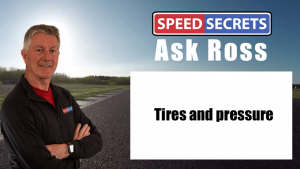 Q: “My tires have a small, raised triangle on the sidewall, near the top of the tire where the tread starts. Local legend suggests optimum/maximum tire patch is gained when the sidewall deflection/rollover/rub line (chalking tires) just touches the tip of this triangle. Is this true/false, a quick-and-dirty gauge, or totally wrong? I’m not suggesting this method, if viable, is a replacement for temperature readings across the tire. However, I’m curious because as an HPDE-only type, I don’t have the equipment, crew, and track time to properly use the temperature gauge method. I noticed that my street tires – Michelin Pilot Super Sport 4S have a tiny Michelin Man in a similar spot as the triangle on the R888R’s. So, it’s gotta be there for a reason, right? The question is: For what purpose?”
Q: “My tires have a small, raised triangle on the sidewall, near the top of the tire where the tread starts. Local legend suggests optimum/maximum tire patch is gained when the sidewall deflection/rollover/rub line (chalking tires) just touches the tip of this triangle. Is this true/false, a quick-and-dirty gauge, or totally wrong? I’m not suggesting this method, if viable, is a replacement for temperature readings across the tire. However, I’m curious because as an HPDE-only type, I don’t have the equipment, crew, and track time to properly use the temperature gauge method. I noticed that my street tires – Michelin Pilot Super Sport 4S have a tiny Michelin Man in a similar spot as the triangle on the R888R’s. So, it’s gotta be there for a reason, right? The question is: For what purpose?”
A: In my experience, what you’re suggesting with the triangle or Michelin man are quick-and-dirty methods to tune tire pressure and camber angle, although I can’t tell you whether the tire companies mold them into the tire for that specific reason or not.
A part of the process you don’t mention though is your feel for the grip versus what the wear on the edges of the tires look like. That’s more important than simply saying that some part of the triangle is being worn. I wouldn’t rely on someone saying that some or all of that triangle should be worn, just like using chalk is incomplete. If, after you’ve run a track session, you sense and noted that the tires felt particularly good or bad, then compare that to how much of the sidewall has been worn (obviously, that means making note of this before and after the session). Over time, you will see a trend of how much sidewall wear relates to the best grip level. The key is you paying attention to how the tires feel, and then relating that to what you see when you “read” the tires afterward.
You may want to take a quick photo with your phone before and after each session of each tire, then make a note of how they felt. While the sidewall deflection is one thing you should “read,” also make note of the surface of the tire, and how the edges of the tread look, too.
None of this will help if you don’t at least keep track of your cold and hot tire pressures. If you find what the sidewall looks like when the tires feel at their best, but you don’t make note of what the tire pressures were, how will you be able to reproduce that setup again? All you need is a good tire pressure gauge to do this. Check and write down what the pressures are before you go out (also make note if this is a true cold pressure, or just a pressure after they’ve cooled down after the previous session which was ____ minutes ago; also make note of the ambient temperature). Then, when you come into the paddock after the session, check the pressures again for the “hot” pressures. Since they will have cooled off some amount since you were at speed on track, these will not be the actual hot pressures. But if you do the same type of cool-down lap, and check them each time as close to the same amount of time after stopping, you should have fairly consistent readings. Things like the ambient temperature and whether your tires are in direct sunlight or not will also impact this, so the goal is to be as consistent as possible. Again, relate what you felt to what the pressures are. Over time, you will learn what pressures relate to the best grip, along with what the tread and sidewall wear looks like.
Of course, tire pressure is just one factor when looking at all of this. Camber and toe also have a big impact on what you’re going to feel and see.
I touch on some of this in the How to Tune Your Car’s Handling eBook – it’s available to download for free at https://speedsecrets.com/tune-car-handling/
Also, check out this past post about tire pressures at https://speedsecrets.com/q-how-do-i-find-the-ideal-pressures-for-my-tires-for-driving-on-track/. And then read what my friend, Samir Abid has to say about tuning tire pressures at https://www.yourdatadriven.com/procedure-for-setting-racing-car-tyre-pressures/.
